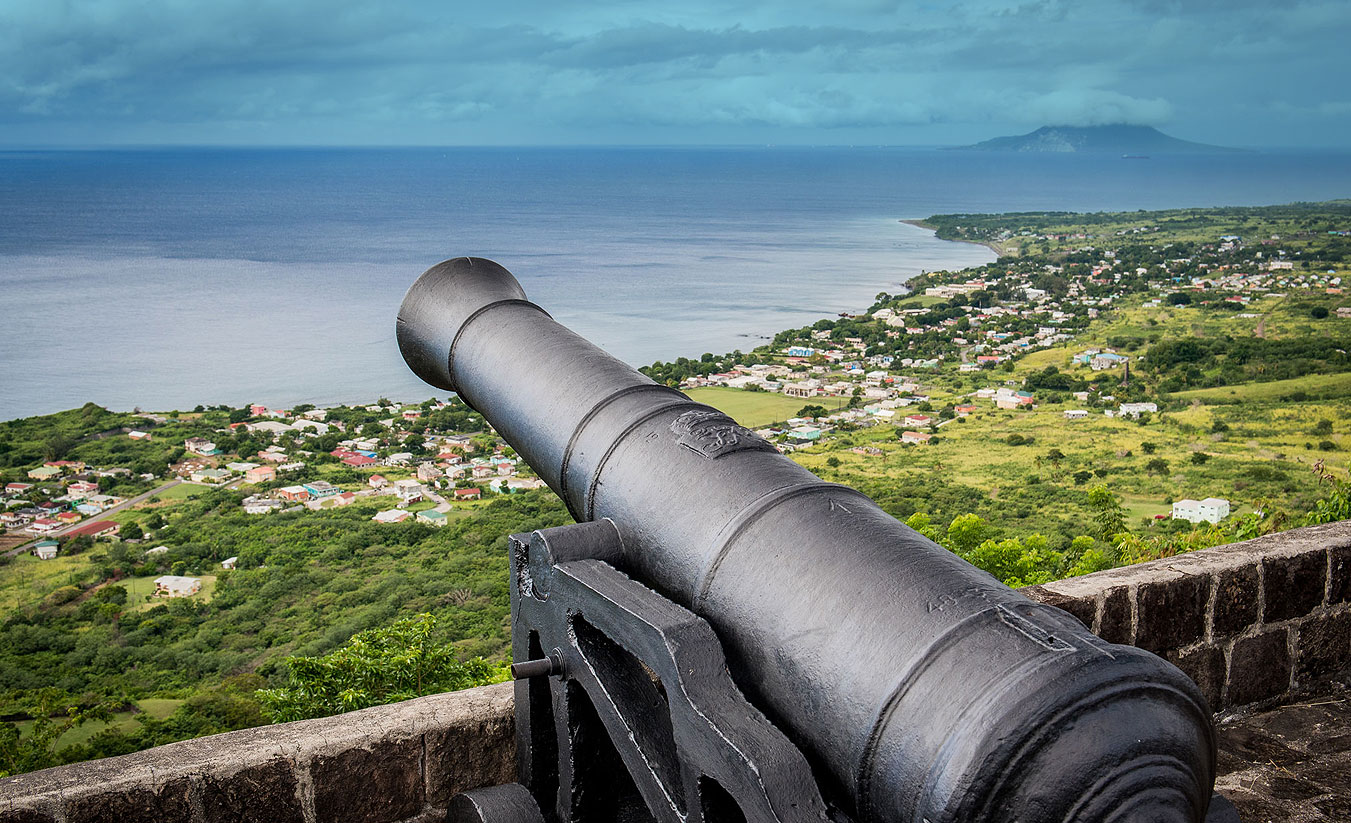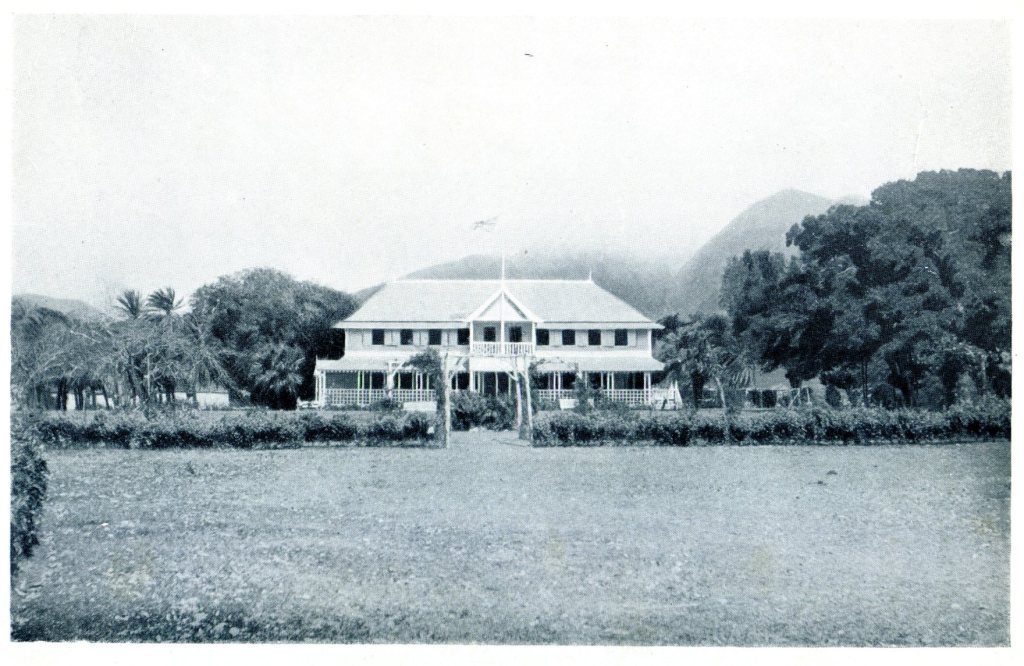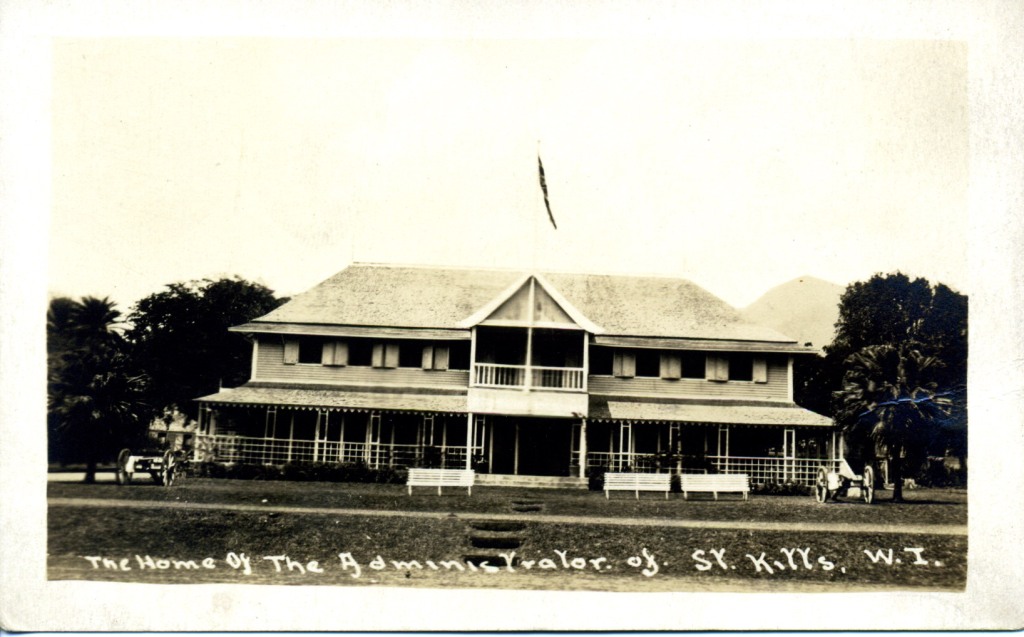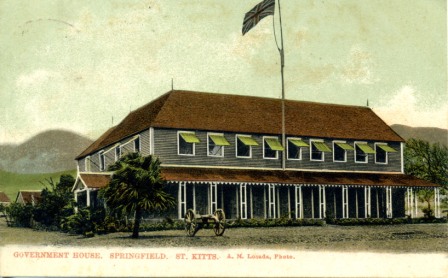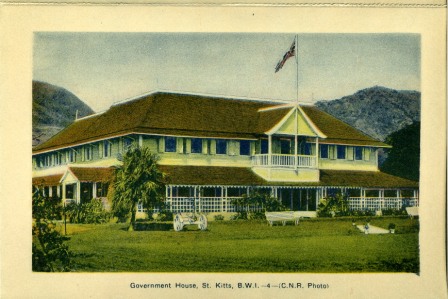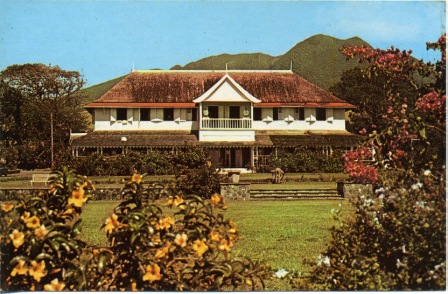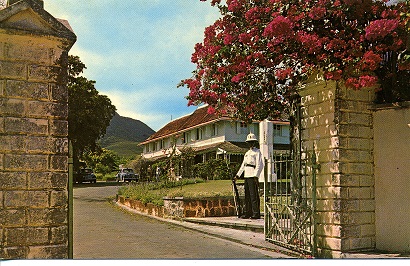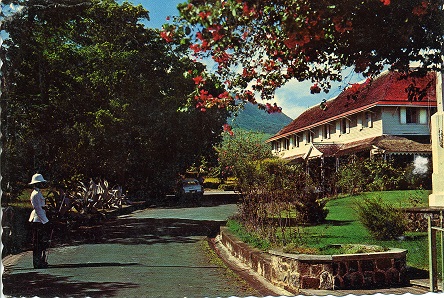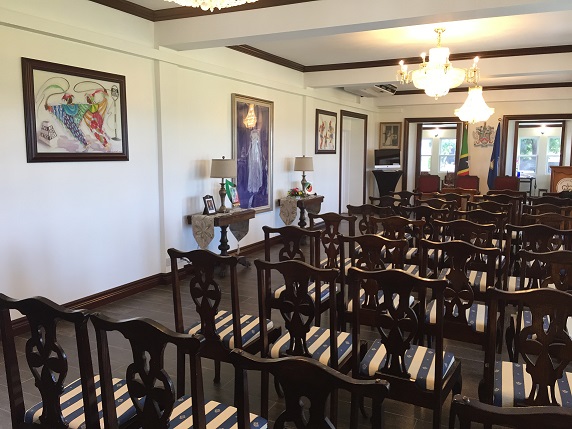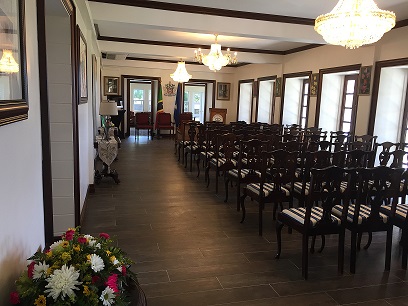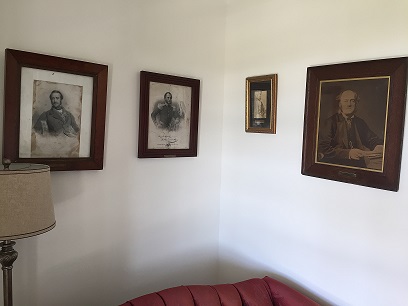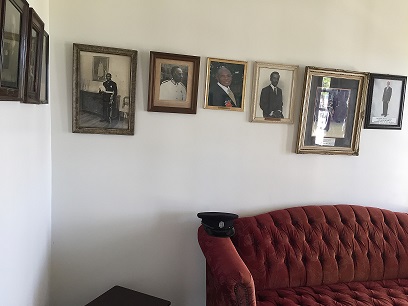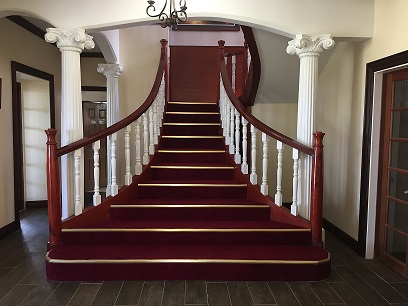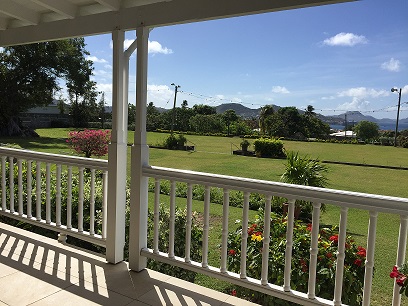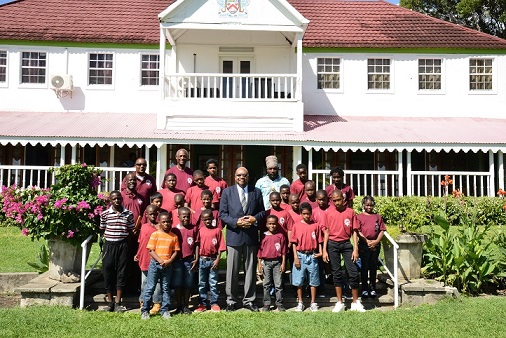Government House
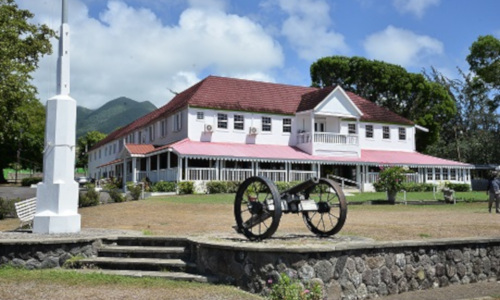
Government House 2015
The land that became known as Springfield was a small part of Diamond Estate. It 1828 it was the property of Sir James Henry Blake, the second son of Sir Patrick Blake of Langham, an absentee land owner. Besides Diamond, he also owned Pinnel, an estate of one hundred and ninety seven acres in the Parish of St. Ann and had land in Montserrat and the counties of Middlesex, Suffolk and Sussex in England. Diamond consisted of one hundred twenty-four acres of land of which one hundred thirteen acres were under cane. The rest was grassland and land occupied by sugar works and slave quarters. The estate was physically divided into two.
The Blakes, being absentee planters, were leasing the estate to William Derrickson Beard who had previously been their manager. There was on it a population of sixty-two slaves, fifteen of whom were too young to work and one, a man in his forties was infirm. The majority were employed as field hands and grass pickers. There were also a distiller, a carpenter, two coopers and one boiler who would have worked on the estate in crop time and might have been hired out to neighbouring estates once the canes of Diamond had been processed. There were three house servants - a house boy, a house maid and a cook. As they were not resident, the Blakes left their managers to provide for their own comfort.
In 1837, Sir Henry Blake sold the twenty-five acre lot to Thomas Harper who renamed it Springfield and built a house on it. Because the latter ran into debt, the property passed into the hands of Robert Sharry Harper trustee under the marriage settlement of Mary Sharry Harper nee Amory.
The Brathwaite Scandal
On the 29th September 1848, the estate and its house was mortgaged to the Reverend Francis Robert Brathwaite but before long the Rector was forced into an extended leave of absence following accusations of a public scandal. He returned to St. Kitts in 1853. George Moffat, Captain of the barque Parrock Hall and a frequent visitor to the island, described him as “a complete Giovanni in canonicals.” The Archdeacon’s behaviour was blamed for the madness of Mary Berridge, a member of a prominent Kittitian family, and her eventual death. In a letter to his wife dated 28th January 1854, Moffat explained, He seduced her some seven or eight years ago under promise of marriage; he subsequently proposed to her niece but was refused; he has since been engaged to several other ladies, while still more serious charges are accumulating against him. I think Miss Berridge had always hoped he would eventually do her justice, she ever severely repressed her feelings but at last could hope no longer, and brain first, and life next, gave way. At the funeral Mr. Braithwaite met the body at the gate of the churchyard in company with the other clergymen (he, Mr. Braithwaite, not being allowed to do any duty) and stood close to her family around the grave! I should, had I been her brother, been tempted to knock him in.
Bishop Daniel G. Davis in Antigua warned Braithwaite not to attempt to take up his official position in St. George’s until an investigation had taken place. Davis, a man of integrity and social commitment, was a Kittitian and would have been familiar with some of the well-established families on the island. He could not afford to antagonize the Berridges and their circle, many of whom would have been friends of his from childhood. Nor was he likely to tolerate such irresponsible behaviour from a man under his jurisdiction. Braithwaite preferred to resign rather than answer questions about his conduct.
In 1854, news of a virulent cholera epidemic in the Caribbean started reaching St. Kitts. The deadly disease made its way to Kittitian shores before the end of the year. The Cunningham Hospital could not handle the number of persons needing attention. The proximity of cholera victims to patients in the hospital was a health hazard. The house at Springfield presented a solution to the dilemma and was quickly set up as a house of refuge for the diseased and destitute.
Anglican Rectory
In April 1855 the 25 acres of Springfield Estate was conveyed in trust among other things for such public uses and purposes as from time to time should by the Governor, Council and Assembly be declared and appointed. Soon after the Artillery Corps started drilling on the estate grounds while Reverend Henry Willoughby Jermyn, who had succeeded Braithwaite, expressed a willingness to use the house as his rectory. The Administration saw this as an opportunity to save on rent for the accommodation of the minister responsible for St. George’s. Repairs were started immediately and in February 1856 Archdeacon Jermyn moved in.
Archdeacon Gibbs
Archdeacon Jermyn was succeeded by William Poore in 1858. In 1861 Archdeacon George Meade Gibbs took charge of the Parish and two years later he hosted the Rev. John Duport, a Kittitian of African descent, who had been sent to Africa as a missionary. On the 17th August 1863 an open air service was held on the lawn at Springfield. It is reported that it attracted a congregation of over three thousand who went to hear Duport speak. The missionary’s visit was a memorable event which was recorded in the photographs that were distributed to interested parties abroad and sold locally to raise funds for his mission.
In 1872, Henry Booth who came to St. Kitts to build the new organ at St. George’s visited Springfield House and commented on it in his diary. On the grounds Booth noted the large number and wide variety of trees. He was especially interested in the giant Banyan.
The 1860s saw a change in the attitude towards the church. Its privileged position as the Established Church of Great Britain and most of its Colonies was coming into question. The Colonial Office recommended the disestablishment and disendowment of the Church of England in the Crown Colonies on the ground that it included only a small minority of the population. It was therefore difficult to justify the States’s payment of the Church’s expenses. In St. Kitts the disestablishment of the Church was enshrined in Act 7 of 1874 which however preserved the rights of the existing incumbents. When Archdeacon Gibbs retired in 1882, Springfield House was again available for use by the island’s administration.
Eldridge’s Troubles
In June 1882, C.M. Eldridge was appointed President of St. Kitts. On his arrival he was allowed to occupy Government House till the 1st August. By then both houses were in need of repair but Springfield seemed to be faring worse. In June 1883, President Eldridge asked permission to leave Springfield and move back to Government House on Victoria Road as he did not feel that the dwelling could last through a difficult hurricane season. The extensive damage must have been the result of exposure of a wooden structure to tropical conditions. The rains that had caused the flood of January 1880 would have exacerbated the problem.
The building was inspected by William Woolward, master carpenter. He found that the ground floor, which was built in stone, was still in very good condition but the upper storey was in dire need of repair. It required new sills, new beams throughout, new roof, new flooring, new boards, shingles, and casing for sides, new partitions and staircase to a total of £600. The only portion of the house remaining in anything like good order being the roof and floor of the small room above the pantry and about two-third of the uprights of the building itself
in April 1884 Eldridge again wrote to the Colonial Secretary insisting Springfield is barely habitable, and in consequence of the leaks, I would gladly have moved could I have obtained quarters. He complained that the scarcity of houses made finding alternative accommodation very difficult. He made another appeal in 1887. The dilapidated state of the house in 1883 has gradually increased, it is now neither wind nor water tight, and the Surveyor of works has declared that it is not safe in Hurricane season. I therefore pray that these repairs may be commenced before the wet season sets in, as my family have already suffered from the exposure to damp. There was little that he could do to make his family comfortable as he was not allowed to draw he £60 rent allowance which would have been his had Springfield not been available. Further, the salary of £1000 which had been voted for his post was reduced to £800 on instructions from the Secretary of State.
Work on the house finally got started that same year. The President visited the site regularly and commented he had never seen a building so thoroughly worm eaten. The whole roof with the exception of one rafter had to be replaced. By October the sum of £258 15s. had been spent and it was estimated that a bath house, wine room and pantry were going to cost another £60. The President became very enthusiastic about the project and even used his own money to pay for the roof of the pantry and bath room. He hoped that this would be repaid to him from the vote for general repairs. He also started making plans to improve the grounds at his own expense until he heard of the possibility of the land being taken up for the expansion of the Methodist part of Springfield cemetery. Eldridge complained that this proposal would so impair the sanitary condition of the house as to render the place untenable.
Finally the future of the whole project was in question when the Governor refused to sanction any further repairs to Springfield House unless the President’s salary was reduced again. Eldridge was horrified. No longer a young man, and with years of service behind him he found the suggestion shocking especially as such a cut would also affect his pension. It was something that he did not have to worry about. Eldridge died in October of 1888. James Henry, who had been the President’s butler was asked to remain as caretaker until the arrival of the new president. The furniture which had belonged to the late President was sold leaving the house empty. A considerable amount of lumber from the construction work remained on the premises. Henry continued to look after the place till April 1889.
Economy
J. S. Churchill, Eldridge’s replacement must have been made aware of the problems experienced by his predecessor. Not wanting to be burdened with furnishing Springfield at his expense, he offered a business solution. He asked that the reception rooms be furnished by a loan taken by the Government and that he and his successors should be bound to pay 10% annually over a period of twenty years. When the debt was fully paid the furniture would remain the property of the Government.
In 1895 T. Risley Griffith was appointed Administrator of St. Kitts. Soon after his arrival, he had to prepare the dwelling for the Governor’s visit. Numerous items of furniture were removed from Government House and placed at Springfield furnishing the dining room and two bedrooms. Living room furniture was to be purchased in an upcoming sale. By the 27 January 1897 the drawing room and another bedroom were also ready. There were new kitchen utensils in the house but Risley Griffith reported, there is no linen of any kind or description nor is there any cutlery or plate in the house, but with these exceptions, I think I may say that Springfield House is sufficiently furnished to make Your Excellency and Lady Fleming and a private Secretary fairly comfortable. He blamed the tardiness of the Crown Agents for the lack of these items. He offered to make some available from Government House and suggested that the Governor might want to bring linen and cutlery with him.
Springfield house contained a grand entrance hall and a separate dining room and drawing room of significant proportions. There were five bedrooms, the largest measuring 22 feet by 18 feet and the smallest measuring 11 feet by 18 feet. The windows and doors were installed with gauze jalousies to protect the inhabitants against mosquitoes. There was a pasture in front of the house and a patch of guinea grass in the back of it. Tennis and croquet courts were on the grounds and the garden contained a few ornamental shrubs and flowers all of which were maintained by convict labour. The house was furnished by the government which was also supposed to provide such essentials as plate, linen, crockery and glass, candlesticks and lamps. Candles and oil however were at the expense of the governor.
In 1900 Administrator Charles Cox asked for a vote for furnishings. He also wanted a piano to be purchased in England for £60 and was prepared to pay 5% annually towards the cost. An Angelus Player Piano and a quantity of roll was purchased in 1915 from Sir Herbert Marshal for the price of £120. When Administrator, J. A. Burdon, took over the following year he found that the piano was not working. He attempted unsuccessfully to have it repaired locally and finally sent parts back to England. The manufacturers said that they had not been told that the instrument had been purchased for a Government House in the tropics. If they had known they would have recommended a different instrument which would also have been more expensive. The silent instrument was sold at auction for just over £28 and a good second hand piano was bought locally for the price of £50.
In July 1909 the sum of £250 was voted for the erection of a carriage house and stable at Springfield. Up to that time, the Administrator had used the stables of the Municipal Department, at La Guerite but his arrangement had been inconvenient as those stables might be required at any time for the stabling of the stock necessary for the scavenging of the town. In 1925 Administrator J.R. St. Johnston arrived in St. Kitts. He described Springfield in his book From a Colonial Governor’s Notebook (London, Hutchinson, 1936, p.123-124)
The use of Government House on Victoria Road as an official residence came to an end during the war years and in 1946, the dwelling became the home of the Girl’s High School. From then on Springfield became the official residence of the Her Majesty’s representative on the island. In 1967, the Governor of Associated State of St. Kitts, Nevis and Anguilla, Sir Fred Phillips was resident there. He was followed by Sir Milton Allen, the first Kittitian of African descent to hold the post. The house continued to be maintained by Public Works but very little structural change took place until 2004 when a large dinning room was added and the offices of the Governor General and his staff were expanded. The house is currently occupied by Sir Cuthbert Sebastian the second person to hold the title of Governor General of St. Kitts and Nevis.
Governors
- Sir Fred Phillips 1967-1969 (Sir Fred Phillips, Caribbean Life and Culture: A Citizen Reflects (Jamaica, Heinemann, 1991)
- Sir Milton Allen 1969-1975
- Sir Probyn Innis 1975-1981
- Sir Clement Arrindell 1981-1983
Governors General
- Sir Clement Arrindell 1983-1996
- Sir Cuthbert Sebastian 1996-2013
- Sir Edmund Lawrence 2013-2015
- Sir S W Tapley Seaton 2015-
Government Headquarters
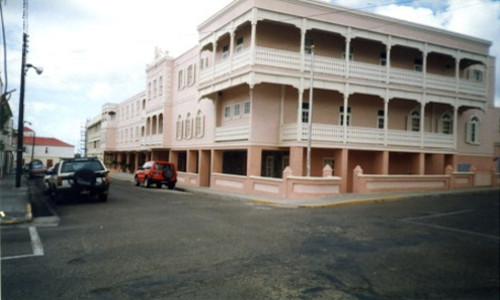
GOVERNMENT HEADQUARTERS is located on Church Street and occupies the land on which the Newstead and the Waterloo buildings as well as some smaller private residences once stood.
In the late 19th century the lower western corner of Church and Central Street was dominated by an impressive building known as the Newstead Hotel. It was a guest house owned by a Mrs. Millard and it catered to a small tourist trade mostly from North America. During the Second World War it became the temporary headquarters of the B division of the Leeward Islands Battalion of the British West Indies Regiment.
The island’s administration acquired the building on the 1st December 1945 for the price of £5000 which at the time was considered very expensive. Government was growing and areas which were once administered by the Leeward Island Federation were becoming the responsibility of the various islands. The building housed the departments of Social Welfare, Education and Labour. In 1949 it also welcomed the extramural office of the newly founded University College of the West Indies until 1970 when it moved to its present location.
In 1956 the Leeward Islands Federation, which at the time consisted of the Presidencies of Antigua, Montserrat, St. Christopher and Nevis, and the British Virgin islands was dissolved as a prelude to the launching of the Federation of the West Indies. This meant that that each territory had to assume responsibilities for the running of its entire administration whereas previously some departments were run from a central office in Antigua. New offices had to be created and housed. A new structure was to be constructed on lower Church street on the site adjoining the Newstead building and occupied by the Waterloo building and other private residences.
In St. Kitts the task of designing the new Administration Building was given to architect Colin Laird. His design produced a three storey structure around an open lobby to allow air to circulate. Conscious of the heat generated by the tropical sun, Laird recessed windows in the front of the building and created wide galleries overlooking the lobby to maximise shade to maximise shade.
The new building was completed in 1965 and housed the Legislative Council Chamber and offices for the Chief Minister and three other ministries. In 1967, when the island assumed Associated Statehood some of these office had to be moved out into other public buildings. Over time space became a premium and some offices actually extended into the open but protected galleries.
In 1993 the administration decided to extend the building into the land occupied by the Newstead. Maintenance was inconsistent and termite damage was becoming prevalent. Throughout most of the late 1980s the building stood vacant, a distant memory of its former elegance. Finally in 1994 it was pulled down to make room for the expansion of Government Headquarters. The renovated and extended Government Headquarters was officially opened in 1995.
In 1981 the Treaty of Basseterre, launching the Organisation of Eastern Caribbean States was signed at Government Headquarters.
PREMIERS
- Robert Bradshaw
- C. A. Paul Southwell
- Lee L. Moore
- Kennedy Simmonds
PRIME MINISTERS
- Kennedy Simmonds
- Denzil Douglas
College Street
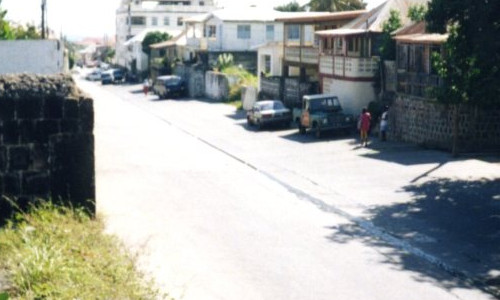
When the tiny settlement of Basseterre was founded in 1627 College Street was very likely its western boundary but with the growth of the population and the construction work undertaken by Governor De Poincy, the settlement gradually grew into a small town.
College Street got its name from the Jesuit College which was erected north of the town (now Douglas Estate). The Jesuits had replaced the Capuchins in 1642 after De Poincy expelled them for what he considered to be interference in the very volatile politics of the island.
By the end of the 17th century, numerous battles were fought for the control of the island. In 1713 under the Treaty of Utrecht, France was required to give up its interest in the island and St. Kitts became a British possession. The land that had formerly belonged to the French became available for settlement by others but some of it had already been occupied. A number of poor people settled in College Street. Among them were Darby Sullivan, John Perschon, James Mitchell, Thomas South, Thomas Norman, Mary Barry, William Price, James Neale, John Papin, Peter Duey, James Goffe, John Mackenze, and Christopher Mardenborough who together petitioned the Commissioners who were appointed to sell the French lands to allow them to keep the land they had settled on. The Commissioners however thought the property was too valuable to be left in the hands of a few poor families. Instead they were given land near the Salt Ponds on the South East Peninsula where they and their descendants were left to eke out a living as best they could.
At the bottom of College Street there was a customs house at the beginning of the 19th century. At this point it is not clear when it was erected there but it might have happened soon after the English take over of the island. This location placed it close to Church Street, which was the centre of administration for a number of years until the Court house was erected in the Square in 1792.
However College Street has a history that is closely linked to its geographical location. The street is actually located in a ghaut or a river. The rainfall in hills above St. Peters, that collects in the Olivee's and Fountain Rivers flows down College Street.
On the 12th April 1792 the St. Christopher Chronicle published this story which was reproduced in the Cornwall Chronicle and Jamaican General Advertiser 23rd June 1792.
On Saturday night we were visited by one of the most dreadful calamities that has been experienced in this devoted island.
We had for several days before frequent showers of rain: but on that night it fell so heavy that it appeared to come down as sheets of water.
A little before ten a prodigious flood came down College Street, carried away or greatly damaged every home from Lt. General Lossack’s estate to Mr Jules house near the little market; it took a little turn a little above this house, carried away the parsonage house, and all the small ones adjoining, burst with incredible violence through the church which providentially (being a large body and very strong) divided it into three streams; one took its course towards the gate that leads into Cayon Street and forced its way through Mrs Byrnes and Mr Queely’s yards and then into Cayon and Church Streets.
Another of the tremendous bodies of water passed a little to the eastward of the former and lodged against all the houses from Church Gate to the unfortunate Mrs. Tudor’s late dwelling.
The third went round the Eastern Part of the Church and ran directly into Mr. Skilling’s yard, from hence meeting no outlet, it passed into Captain Ford’s and Captain Slegg’s yards where, meeting with the same opposition as Mr Skillings it forced away the fence and an out house of the editor’s. At this critical moment the families of the above mentioned house were retired to rest and were unacquainted with their danger. The Editor and family alone were up who, finding the pressure of the water and the quantity that was forcing itself through the crevices immediately through every door open. The water flowed breast height with prodigious force through three doors in the front of the house, that emptied the water into Cayon Street, which at this time ran beyond the power of a mortal to describe.
Outhouses, lumber, casks etc were then flowing into the editors yard that it was with great difficulty they were kept from choking up the passages for the tremendous body to pass that entered the back of the building. In the situation he continued some time till when the flood was at its greatest height and when he did not expect to stem its violence any longer, Mrs. Tudor’s house gave way and made a large breach for the water at the same time as Captain Slegg’s house, which was occupied by one of his negroes, who was carried away in the house, but was providently saved in the market adjoining the printing office, went.
Poor Mrs. Tudor, who lately buried an amiable son, has now to lament the untimely loss of an amiable daughter. The mother and son were happily taken out of the surf – they were much bruised, but are a fair way to recovery. But Mrs. Tudor has not been heard of since – she rests with the dead.
Two daughters of the late Mrs Jane Lewis who died about four weeks ago were also in the house; one of them shared the fate of Mrs. Tudor, the other was saved in the square.
Another catastrophic event took place in 1880. On the night of the 11-12th January 1880 the dangers of College Street were made vividly and fatally clear. The Official Gazette of St. Christopher estimated that 36 inches of rain fell in less than six hours. Two hundred thirty one persons lost their lives but only one hundred sixteen were actually recovered. The whole of Basseterre suffered sever damage but the buildings on College Street were torn from their foundations and carried to the sea. The water mains broke and water from the reservoir added to the already significant damage which extended all the way across Pall Mall Square (now Independence Square). In his report on the protection of Basseterre against flooding, Captain S Arthur Alexander of the Royal Engineers then in Antigua, blamed the disaster on the poor choice of location for the town. He said that it was on the flood plain of a number of small rivers that flow from the surrounding hills but it should have been located on the bluff occupied by Fort Thomas and extended into the estates of Limekiln, Buckley and La Guerite and recommended that the town be relocated there. However realising that this might not have been feasible he made a number of suggestions which included the clearing of the land between Market Ghaut and College Ghaut of every structure and strong retaining walls built particularly on the Eastern Side of College Street between the Moravian and Anglican churches. Civil Engineer Blanc saw the flooding as a consequence of neighbouring estates not clearing accumulated sand and debris, This was an ever present task. In 1886, the Executive Council was informed that such sand was removed to the yards of houses in New Town and to Lucas estate (once located in the area now occupied by TDC hardware store.)
In 1884 the necessary law for the protection of Basseterre against flooding was passed, It gave the Governor-in-Council the authority to acquire the land to be cleared as long as its cost, along with the cost of construction of the retaining walls, did not exceed the vote provided for this project. The intention was to follow the directions set out by Captain Alexander. In 1885 the Governor was empowered to raise the necessary funds through debentures. Acquisition of the land started in 1888 (Recorded in th St. Christopher Register Series 4, Vol. D) and resulted in the widening of College Street to its present dimensions. Despite these changes when the rainfall is very heavy, flooding continued to occur as in 1924
For a number of years a culvert allowed the water coming from the hills to trickle down the Ghaut and into the street to the sea. However after Hurricane Hugo a bridge was built linking the top of Market Street to the top of College Street removing obstacles that might have hindered the flow of flood water as well as improving the movement of traffic. The wisdom of this decision was seen first during the passage of Hurricane Georges (21 Sept 1998) which lingered over St. Kitts for a long time and caused considerable water damage. It was further emphasised on the night of the 28th November 1998 when an enormous amount of rainfall in just a matter of hours again caused flooding in College and Market streets and spread mud throughout most of central Basseterre. The torrent was such that it covered the bridge for a while and when it subsided. People crossing the bridge on their way home from a concert at the Basseterre High School could see boulders being tumbled under it by the still turbulent waters.
College Street remains a place to be avoided when rain starts to fall even if the showers are light as it is not always possible to tell how much rainfall had already poured in the hills above Basseterre.
Court Hou
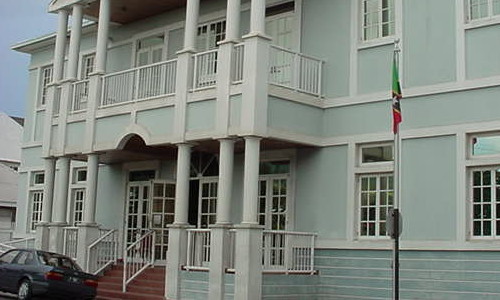
When the British took over Basseterre in 1713 they slowly moved their institutions of administrations and justice from Old Road to Basseterre and more specifically to Church Street. It was not long before these early structures were outgrown by the need for space and new locations had to be found.
Plans to erect a court house in the Square were first formalised in an Act passed in 1750. It was obvious even then that the building was to house a number of offices which included that of the Public Secretary, the Registrar, and the meeting rooms for the Council and Assembly. A jail was to be built close by. These arrangements did not materialise immediately.
In 1772 the meeting place of the Assembly in Basseterre was completely destroyed by a hurricane and the lumber and shingles were sold for fear that the might be lost to thieves. A new place had to be found for meetings making the construction of a new council hall more urgent.
It was in 1792 the administration acquired the property called The Tontine on the south eastern side of the square. The property measuring 70 feet from North to South and 104 feet from East to West had belonged to the Rawlins family but was then the property of Webbe Hobson who had acquired several pieces of land around Pall Mall Square. The Tontine cost Government 5500 pounds current money. In part payment, Hobson was given the Old Court House which had been located on the Eastern side of Church Street on a lot measuring 51 feet from North to South and 142 feet from East to West and valued at 800 local currency. The balance was raised by a tax on slaves and on real estate in Basseterre, Old Road and Sandy Point. In February 1793, the tax assessments had not been completed and a new act placed the matter in the hands of the parish constables and penalised those who did not pay it.
The new Court House became the home of various courts. These included
* Vice Admiralty Court which dealt with offences committed at sea including the illegal importation of slaves after 1807 when the slave trade was abolished
* Court of Kings Bench/Queens Bench and Common Pleas which was a senior court of common law, with civil and criminal jurisdiction
* Court of Chancery which dealt with disputes relating to estates
There were also a number of smaller courts including Grand Sessions, Quarter Sessions, Special Sessions which dealt with criminal charges against slaves, Court of Errors, Court of Complaints, Insolvent Debtors and Debtors, Magistrates’ Court, Special Justices – these were the stipendary magistrates who were appointed to deal with matters arising during Apprenticeship. Only the magistrate who sat in Basseterre would have used the Court House.
The Courthouse was also significant from the point of view of administration of civil matters. It housed the offices of the Land Registry and from 1817 to 1834 provided facilities for the Registrar of Slaves. It also provided accommodation for the Assembly and the Council. Effectively, this meant that the centre of administration had shifted from Church Street to the Square from 1792. In 1894 the building became the home of the Public Library which was responsible for numerous archival holdings until a partial move to the new Administration Building was made in 1965. For a number of years, the Ministry of Health was also located at the Court House.
Over the years the Court house was the meeting place for the Royal Commissions that visited the island to investigate conditions here.
The building burnt to the ground on the 1st of September 1982. Ten years later, Hugh A C Martin and Associates of Puerto Rico designed a new complex and Stephen and Associates of St. Kitts undertook the construction. The construction of the present building using mainly concrete and which mirrors the look of the facia of the old building was completed in 1998. Much of the delay in completing the building was due to its location at a point where there are continuous water table fluctuations.
Today The building houses the Registrar’s Offices, Traffic citations, and Criminal and Civil courts. A new building at the western side of town, adjacent to the Clarence Fitzroy Bryant College now houses the Charles Halbert Public Library. In 2004 the Court House building was renamed the Sir Lee L. Moore Legal and Judicial Complex.
Historical Trials
1826 Following concerns raised by Governor Charles Maxwell, a Grand Jury was convened to hear charges of cruelty against Richard Cardin who had kept Betto Douglas, a fifty-two year old, enslaved woman in the stocks for six months after she had demanded her freedom. The case was dismissed as frivolous.
1828 Captain Lazaro Buysan and the crew of thirty three men of the schooner Las Damas Argentinas were tried for piracy on the high seas after they attacked the Carraboo, an English brig while it was close to the Canary Islands. The pirate vessel was seized in the straits between St. Kitts and St. Eustatius. A young lawyer, James George Piguenit was assigned the defence of the Captain who was tried separately. Quartermaster Henry Harrison and ship’s surgeon Elias Harry Merriman were admitted as King’s Evidence. Five crew members had been recruited after the incident had taken place. Two cabin boys and an American who was sick at the time of the attack were reprieved. Two cabin boys and an American who was sick at the time of the attack were reprieved. The rest were executed on the gallows which were located in the place now occupied by the petrol storage facility
1935 Following the labour disturbances better known as the Buckley’s Riots, a number of individuals were brought to trial for rioting and other related charges. Noted barrister at law, Clement Malone (later Chief Justice) defended many of them.
1968 the trial of several persons detained following the 10th June invasion of St. Kitts by Anguillans and American mercenaries. These were dismissed on grounds that the detention order failed to state in detail why the detainees were being held, as required by the Constitution
1975 following the nationalization of the sugar lands, the owners took action against the Attorney General and the Minister of Lands. They were disputing the constitutional validity of the Sugar Estates Lands Acquisition Act of 1975. The court ruled that the act was unconstitutional as the act sought to limit compensation to ten million EC dollars.
Co-Cathedral Of The Immaculate Conception
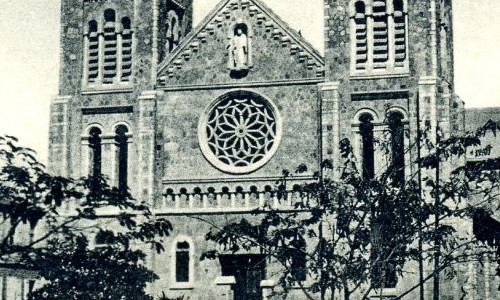
CO-CATHEDRAL OF THE IMMACULATE CONCEPTION is an ornate church constructed out of grey stone and located on the eastern side of Independence Square. In the early years of the French occupation of St. Kitts, the Jesuits had build a Roman Catholic Church and dedicated it to Our Lady. Notre Dame was burned in 1706 during the Anglo-French war and rebuilt later as St. Georges Anglican Church. The catholic congregation in St. Kitts diminished drastically in the years following the Treaty of Utrecht.
In 1713 the English forbade public worship of the Catholic religion in St. Kitts. Wealthy Catholic families erected cupolas on the tops of their houses as a sign for other catholics to come and worship. Only two such buildings remain in Basseterre both on Liverpool Row.
In 1829 an act was passed to remove some of the discrimination against the small number of catholics that were still present on the island. From time to time, the priest in Montserrat visited St. Kitts then in 1842 when Fr. Hugh McShane was appointed the first priest to serve on here. The Catholic presence was greatly enhanced by migration from neighbouring French St. Bartholomew and later by the presence of Madeiran indentured workers . To accommodate the growing numbers a church was to be built. This got underway in 1852 but progress was painfully slow as funds were scarce, Though the walls went up they remained exposed to the elements for too long and they could not support a roof. Fr. Philip Lynch completed the structure by buttressing them and putting on the roof. The Bishop in Roseau Dominica donated the 14 stations of the cross and a statue of the Virgin Mary.
By 1885 the building was in a dilapidated state and could not accommodate the growing congregation. The Fr. Peter Smyth embarked on the project with an impressive ceremony of the blessing of the new foundation. It was attended by the Bishop and the parish priests from Antigua, Montserrat and St. Eustatius. Embellishments to the new church followed.
In 1895 a new bell was bought and in 1899 the organ of the church in Antigua was sent to Basseterre where it stayed till a new one replaced it in 1919.
In 1901 a new set of Stations-of-the-Cross was purchased and in 1903 the statue of the Immaculate Conception was enshrined in the church. However the tropics tend to play havoc on construction material and in less than 20 years the church was again in need of renovation.
In 1923 when St. Kitts was celebrating its first settlement, Fr. Rabaey reminded the congregation that the centenary of Catholic emancipation was due to be celebrated in 1929 and expressed the hope that a new church could be built by then.
Plans were drawn up in 1925 and exhibited to the public the following year. Contributions were received and Fr. Claeys thought it was time to assemble the construction material. He started by purchasing squared stones from Nevis.
In January 1927, the old church was emptied of its furnishings which were moved to the nearby hall that was to be a temporary place of worship. Demolition started on the 1st February. Pavement tiles where removed carefully so that they could be used again in the new church. Construction on the 17th March 1927 and was completed in less than two years. The new structure was dedicated on 6th December, 1928.
In 1981, the church was elevated to the status of co-cathedral within the diocese of St. John’s, Antigua.
National Archives
Government Headquarters
Church Street
Basseterre
St. Kitts, West Indies
Tel: 869-467-1422 | 869-467-1208
Email: NationalArchives@gov.kn
Website: www.nationalarchives.gov.kn
Follow Us on Instagram

